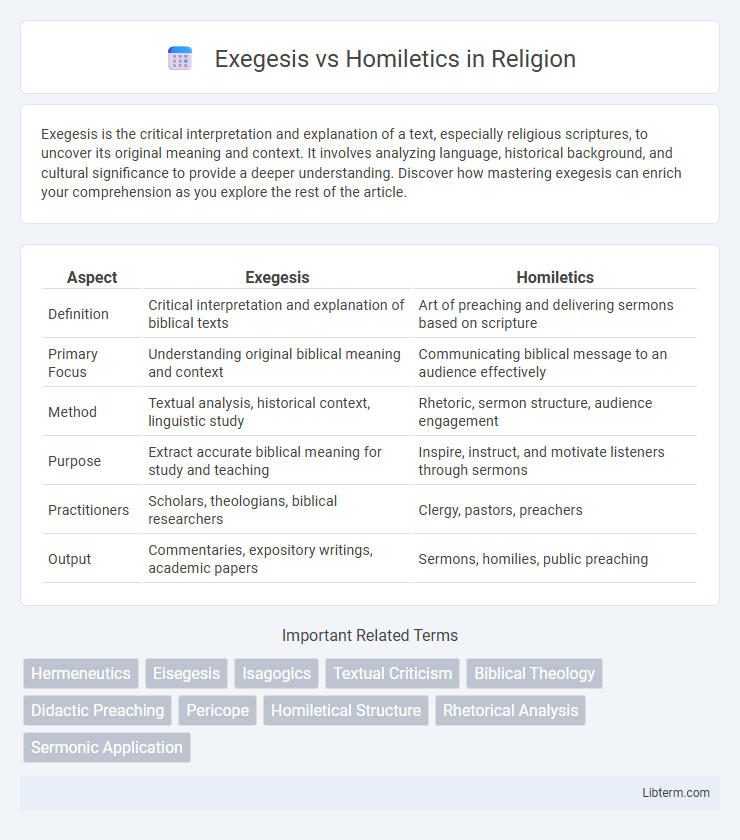Exegesis is the critical interpretation and explanation of a text, especially religious scriptures, to uncover its original meaning and context. It involves analyzing language, historical background, and cultural significance to provide a deeper understanding. Discover how mastering exegesis can enrich your comprehension as you explore the rest of the article.
Table of Comparison
| Aspect | Exegesis | Homiletics |
|---|---|---|
| Definition | Critical interpretation and explanation of biblical texts | Art of preaching and delivering sermons based on scripture |
| Primary Focus | Understanding original biblical meaning and context | Communicating biblical message to an audience effectively |
| Method | Textual analysis, historical context, linguistic study | Rhetoric, sermon structure, audience engagement |
| Purpose | Extract accurate biblical meaning for study and teaching | Inspire, instruct, and motivate listeners through sermons |
| Practitioners | Scholars, theologians, biblical researchers | Clergy, pastors, preachers |
| Output | Commentaries, expository writings, academic papers | Sermons, homilies, public preaching |
Understanding Exegesis: Definition and Purpose
Exegesis is the critical explanation or interpretation of biblical texts aimed at uncovering the original meaning intended by the author within its historical and cultural context. Its primary purpose is to provide an accurate, objective analysis of scripture through linguistic, historical, and theological methods, establishing a solid foundation for further theological reflection. Understanding exegesis involves recognizing its role in bridging the gap between ancient texts and contemporary application, ensuring faithful interpretation before any homiletic or sermonic use.
What is Homiletics? Key Principles Explained
Homiletics is the art and science of preaching, focusing on the effective communication of biblical messages to congregations. Key principles include clarity in sermon structure, relevance to the audience's context, and faithful interpretation of scripture to inspire and instruct. Homiletics emphasizes persuasive delivery, ensuring the message resonates emotionally and intellectually with listeners.
The Historical Development of Exegesis and Homiletics
The historical development of exegesis traces back to ancient Jewish and Christian traditions, where meticulous scriptural interpretation aimed to uncover original meanings within biblical texts using linguistic, cultural, and historical contexts. Homiletics evolved alongside early Christian preaching, focusing on the art of delivering sermons that effectively communicate theological truths to congregations, shaped significantly by figures like Augustine and Martin Luther during the Reformation. Over centuries, both disciplines advanced through scholarly contributions, with exegesis emphasizing hermeneutical methods and homiletics refining rhetorical strategies to engage diverse audiences.
Core Differences Between Exegesis and Homiletics
Exegesis involves the critical interpretation and explanation of biblical texts to uncover their original meaning and context, relying heavily on linguistic, historical, and cultural analysis. Homiletics focuses on the art and practice of preaching, transforming the insights gained from exegesis into a coherent and impactful sermon tailored for a contemporary audience. While exegesis is primarily analytical and text-centered, homiletics is practical and communication-centered, aimed at applying biblical truths to inspire and instruct listeners.
The Role of Context in Exegesis and Homiletics
Context plays a crucial role in exegesis by guiding the accurate interpretation of scriptural texts within their original historical, cultural, and linguistic settings. In homiletics, understanding context helps preachers apply biblical messages meaningfully to contemporary audiences while preserving the intended theological insights. Effective integration of context in both disciplines ensures fidelity to the text and relevance in sermon delivery.
Methods and Techniques: Exegesis vs Homiletics
Exegesis employs critical methods such as textual criticism, historical context analysis, and linguistic examination to uncover the original meaning of biblical texts. Homiletics focuses on techniques like sermon structuring, rhetorical devices, and audience engagement strategies to effectively communicate and apply scriptural messages. While exegesis emphasizes interpretive accuracy, homiletics prioritizes practical application and persuasive delivery.
Integrating Exegesis into Sermon Preparation
Integrating exegesis into sermon preparation enhances the accuracy and depth of biblical interpretation by systematically analyzing scripture within its historical and literary context. Homiletics then applies these exegetical insights to craft clear, relevant, and impactful messages tailored to the congregation's needs. This fusion ensures sermons are both theologically sound and practically engaging, fostering spiritual growth and comprehension among listeners.
Common Challenges in Exegesis and Homiletics
Common challenges in exegesis include accurately interpreting ancient texts within their historical and cultural contexts, navigating linguistic nuances, and avoiding personal biases that skew meaning. Homiletics faces the difficulty of translating complex theological insights into clear, relevant, and engaging sermons that resonate with contemporary audiences while remaining faithful to scriptural intent. Both disciplines require a balance between academic rigor and practical application to effectively communicate biblical truths.
Exegesis and Homiletics in Theological Education
Exegesis involves the critical interpretation and analysis of sacred texts, equipping theological students with the skills to understand historical and cultural contexts, language nuances, and original meanings of scripture. Homiletics focuses on the art of preaching and delivering sermons, training students to effectively communicate theological insights and inspire faith communities. Both disciplines are integral to theological education, with exegesis providing the foundational biblical understanding necessary for homiletic practice.
Impact on Modern Preaching: Exegesis vs Homiletics
Exegesis grounds modern preaching in rigorous scriptural interpretation, ensuring sermons accurately convey original biblical meanings and theological context. Homiletics shapes the delivery and structure of sermons, enhancing clarity, engagement, and relevance to contemporary audiences. Balancing exegetical depth with homiletical skill maximizes the impact of preaching by combining doctrinal fidelity with effective communication.
Exegesis Infographic

 libterm.com
libterm.com